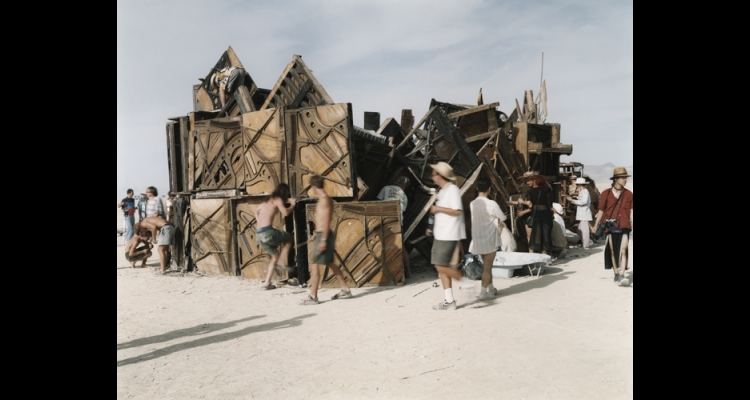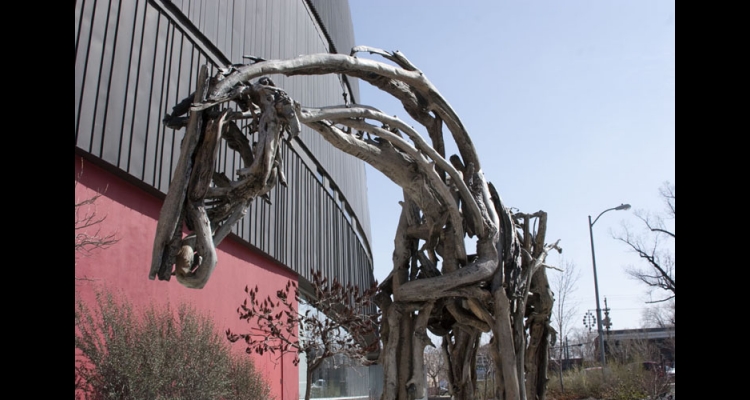Avant-garde in Nevada
Although there may be some truth in the notion that avant-garde art and literature have always been slow to reach Nevada and the Great Basin, there have been, over the years, some noteworthy undertakings. And, like the vanguard works of last century's Modernism, they usually combine verbal and visual expressions.
Nevada's emptiness is one of its attractions—along with its openness, literally and metaphorically. It is a place where a person can take things. To paraphrase actress Thelma Ritter in the classic movie The Misfits, filmed in Reno in 1960, Nevada is the kind of place where people take things they don't want: money to lose, bombs to explode, marriages that don't work. An interesting collection of photographs and journals that trace the photographer Inge Morath's trip to Reno to shoot The Misfits can be found in Inge Morath: The Road to Reno (Steidl, 2006).
But a number of writers, artists and photographers have found that Nevada is also a place to make things. The sculptor Michael Heizer has been working in Nevada for many years, from his late 1960s motorcycle drawings and dye dispersals on various playas and lakebeds to Double Negative (1969-70) on Mormon Mesa outside Las Vegas, and his ongoing monumental project, City, in east central Nevada. A good overview of Heizer's works is found in Michael Heizer: Sculpture in Reverse (Museum of Contemporary Art Los Angeles, 1984).
Jack Fulton, the Bay Area photographer has likewise been working in Nevada for many years—ever since he got a job his last summer of high school in the mid-1950s for the then Bureau of Public Roads laying out a stretch from Elko to Wells. Fulton is fond of saying that he uses one camera, one lens and that "[I] guess you could say I write with it." His work is a curiously compelling hybrid of text and image that become verbal-visual poems. A collection of these (focusing on the Sierra Nevada but dipping down into the Northern Nevada desert) was published as 2 Saunters: Summer & Winter (Pencil Press, 1978). An expanded collection of pieces, with increasingly poetic musings—Suite Nevada: The Prototype was prepared in 1994, but it has yet to find a publisher.
The books that William L. Fox published from West Coast Poetry Review press from the mid-1970s to mid-1980s could be called avant-garde—or at the very least highly experimental—with their mix of concrete poetry and visual textworks by a variety of international artists. The same could be said of Kirk Robertson's ar ti facts, a series of collage/poems which received the Watermark Press Breakthrough Award in 1985.
Under the stewardship of Walter McNamara (from the early 1960s to the late '80s), the Sheppard Gallery at the University of Nevada, Reno, introduced the work of nationally and internationally acclaimed artists to Northern Nevada audiences. Artists showing at the gallery during this period included Robert Arneson, John Altoon., Deborah Butterfield, Bruce Conner, Nancy Grossman, Robert Heinecken, Paul Kos, John Mason, Manuel Neri, Ed Ruscha, Wayne Thiebaud, and William T. Wiley. The gallery's achievements were documented in Sheppard Gallery: 25 Years (Sheppard Gallery, UNR, 1986).
An outgrowth of the programming at the Sheppard Gallery was the Nevada Sites Curatorial Group, an ad hoc collective of writers, artists, and curators who came together to undertake a series of exhibitions relating to specific sites (or non-sites) in Nevada. Members of the group included William L. Fox, Jeff Kelley, Tom Holder, Walter McNamara, and Kirk Robertson. One particularly noteworthy exhibition in the series was "The Pit Show," an exhibition dealing with a dead animal disposal site outside Fallon. The exhibition was reviewed in Artforum—the first Nevada show to be reviewed in the periodical, and the last until a review of Michael Sarich: A Selectrospective, organized by the Churchill Arts Council, appeared in Summer, 2006.
The Fallon site also figured in a number of publications by the photographer Richard Misrach, including Violent Legacies: Three Cantos (Aperture, 1992), which combined images of the Fallon Pit with those of the secret W-47 project in Wendover, a shooting range outside Las Vegas, and an essay by Susan Sontag. The appropriation of Ezra Pound's idea (who in turn adopted the idea from Dante) of cantos as subsections of a longer poem seems appropriate for Misrach's ongoing investigations. Other titles from the series include The Desert Cantos, essay by Reyner Banham (University of New Mexico, 1987), and Crimes and Splendors: The Desert Cantos of Richard Misrach, essay by Rebecca Solnit (Bullfinch, 1996). One stand-alone canto, Bravo 20: The Bombing of the American West (Johns Hopkins, 1990), contains his proposal to turn the bombing range outside Fallon into a national park.
Peter Goin has produced several collaborative volumes that deal with various aspects of Nevada's landscapes, including Nuclear Landscapes (Johns Hopkins, 1991); A Doubtful River, with photographs by Robert Dawson and essay by Mary Webb, (University of Nevada, 2000); and Black Rock, with essays by Paul F. Starrs (University of Nevada, 2005).
Two recent works of fiction draw upon traditional narrative techniques in innovative ways. William Kittredge's The Willow Field (Knopf, 2006) uses the story of a young Reno Basque boy's growing up and out of his world into others to assay the sweep of the twentieth century and modernity. The sprawling narrative uses the personal to assay the political, an elemental meditation on the American West. Reno native Willy Vlautin heads up the critically acclaimed rock band, Richmond Fontaine, and his first novel, The Motel Life (Harper Perennial, 2007), relates the story of two hard-luck Reno brothers' search for meaning among the shards of their past. His stripped down, minimalist prose is very much in the tradition of Raymond Carver, James Welch, and Larry Brown.
Article Locations
Related Articles
Further Reading
None at this time.





